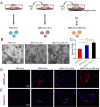Mesenchymal Stem Cell-Derived Extracellular Vesicles in Bone-Related Diseases: Intercellular Communication Messengers and Therapeutic Engineering Protagonists
- PMID: 38601346
- PMCID: PMC11005933
- DOI: 10.2147/IJN.S441467
Mesenchymal Stem Cell-Derived Extracellular Vesicles in Bone-Related Diseases: Intercellular Communication Messengers and Therapeutic Engineering Protagonists
Abstract
Extracellular vesicles (EVs) can deliver various bioactive molecules among cells, making them promising diagnostic and therapeutic alternatives in diseases. Mesenchymal stem cell-derived EVs (MSC-EVs) have shown therapeutic potential similar to MSCs but with drawbacks such as lower yield, reduced biological activities, off-target effects, and shorter half-lives. Improving strategies utilizing biotechniques to pretreat MSCs and enhance the properties of released EVs, as well as modifying MSC-EVs to enhance targeting abilities and achieve controlled release, shows potential for overcoming application limitations and enhancing therapeutic effects in treating bone-related diseases. This review focuses on recent advances in functionalizing MSC-EVs to treat bone-related diseases. Firstly, we underscore the significance of MSC-EVs in facilitating crosstalk between cells within the skeletal environment. Secondly, we highlight strategies of functional-modified EVs for treating bone-related diseases. We explore the pretreatment of stem cells using various biotechniques to enhance the properties of resulting EVs, as well as diverse approaches to modify MSC-EVs for targeted delivery and controlled release. Finally, we address the challenges and opportunities for further research on MSC-EVs in bone-related diseases.
Keywords: bone-related diseases; extracellular vesicles; functional modification; mesenchymal stem cells.
© 2024 Wang et al.
Conflict of interest statement
The authors report no conflicts of interest in this work.
Figures





Similar articles
-
Therapeutic potential of mesenchymal stem cell-derived extracellular vesicles as novel cell-free therapy for treatment of autoimmune disorders.Exp Mol Pathol. 2021 Feb;118:104566. doi: 10.1016/j.yexmp.2020.104566. Epub 2020 Nov 6. Exp Mol Pathol. 2021. PMID: 33160961 Review.
-
Innovative preconditioning strategies for improving the therapeutic efficacy of extracellular vesicles derived from mesenchymal stem cells in gastrointestinal diseases.Inflammopharmacology. 2023 Dec;31(6):2973-2993. doi: 10.1007/s10787-023-01350-6. Epub 2023 Oct 24. Inflammopharmacology. 2023. PMID: 37874430 Free PMC article. Review.
-
Functionally engineered extracellular vesicles improve bone regeneration.Acta Biomater. 2020 Jun;109:182-194. doi: 10.1016/j.actbio.2020.04.017. Epub 2020 Apr 16. Acta Biomater. 2020. PMID: 32305445 Free PMC article.
-
Strategies and Challenges of Mesenchymal Stem Cells-Derived Extracellular Vesicles in Infertility.Tissue Eng Part B Rev. 2024 Jun;30(3):385-403. doi: 10.1089/ten.TEB.2023.0094. Epub 2024 Apr 12. Tissue Eng Part B Rev. 2024. PMID: 38009217 Review.
-
Healing the cornea: Exploring the therapeutic solutions offered by MSCs and MSC-derived EVs.Prog Retin Eye Res. 2025 Mar;105:101325. doi: 10.1016/j.preteyeres.2024.101325. Epub 2024 Dec 20. Prog Retin Eye Res. 2025. PMID: 39709150 Review.
Cited by
-
High-yield BMSC-derived exosomes by the 3D culture system to enhance the skin wound repair.Regen Biomater. 2025 Apr 10;12:rbaf022. doi: 10.1093/rb/rbaf022. eCollection 2025. Regen Biomater. 2025. PMID: 40309353 Free PMC article.
-
Mesenchymal stem cell-derived extracellular vesicles in joint diseases: Therapeutic effects and underlying mechanisms.J Orthop Translat. 2024 Jul 27;48:53-69. doi: 10.1016/j.jot.2024.07.005. eCollection 2024 Sep. J Orthop Translat. 2024. PMID: 39170747 Free PMC article. Review.
-
Synergistic Effects of Natural Products and Mesenchymal Stem Cells in Osteoarthritis Treatment: A Narrative Review.Curr Issues Mol Biol. 2025 Jun 11;47(6):445. doi: 10.3390/cimb47060445. Curr Issues Mol Biol. 2025. PMID: 40699844 Free PMC article. Review.
-
Therapeutic Application of Extracellular Vesicles Derived from Mesenchymal Stem Cells in Domestic Animals.Animals (Basel). 2024 Jul 24;14(15):2147. doi: 10.3390/ani14152147. Animals (Basel). 2024. PMID: 39123673 Free PMC article. Review.
-
Dual release scaffolds as a promising strategy for enhancing bone regeneration: an updated review.Nanomedicine (Lond). 2025 Feb;20(4):371-388. doi: 10.1080/17435889.2025.2457317. Epub 2025 Jan 31. Nanomedicine (Lond). 2025. PMID: 39891431 Review.
References
Publication types
MeSH terms
Substances
LinkOut - more resources
Full Text Sources
Other Literature Sources

